Nursing – personal, under threat and without demarcation lines
Nurses adapt to structures and norms in the health service rather than standing by clinical assessments. Experience is given more emphasis than science.
Background: The Norwegian Nursing Magazine (Sykepleien) issued a special edition entitled ‘#What is nursing really?’ (‘#Hva er egentlig sykepleie’) in 2019, based on a survey of how nurses spend their working hours.
Objective: We wanted to examine how nursing is portrayed and understood in the special edition, and discuss what knowledge is linked to the understanding of nursing, viewed in light of Abbott’s understanding of professions.
Method: The study has a qualitative, descriptive design. In the analysis, we placed the emphasis on the texts and Bendiksen and de Wangen’s photo project. In the text analysis, we followed the steps in Braun and Clarke’s thematic analysis strategy. In the analysis of the photo project, we were inspired by Rose’s method for image analysis.
Results: The study presents nursing within three thematic areas: nursing without demarcation lines, as personal competence, and as a profession under threat. Experiential knowledge seems to be legitimised in the portrayal of nursing care.
Conclusion: The science of nursing and specific clinical knowledge do not appear to play a large role as a basis for action. Instead, the emphasis is on experiential knowledge – particularly personal and interpersonal competence. What knowledge nurses possess, how they apply knowledge in their work, and how knowledge is developed, seem to be overshadowed by the description of nurses’ personal experiences and competence.
In 2018, the Norwegian Nursing Magazine (Sykepleien) conducted a survey of its members, in which they were asked how they spend their working hours (1).
A total of 2000 of the roughly 10 000 registered nurses (RNs) who were invited to participate responded to the survey. The results showed that many RNs were doing tasks that they thought other occupational groups should be doing. The survey resulted in a special edition of the Norwegian Nursing Magazine entitled ‘#What is nursing really?’ (‘#Hva er egentlig sykepleie?’) in 2019.
Questions about what nursing is have been asked in the Norwegian context ever since the Norwegian Nurses’ Organisation was founded in 1912. Lund (2, p. 15) points out that there have been internal conflicts in the nursing profession about the relationship between theory and practice, and about what the theoretical basis should be. The issue of theory versus practice in particular came to the fore in the 1970s (3).
There was considerable debate about the importance of scientific knowledge, models and conceptual frameworks for establishing nursing as a science, in contrast to practice-based forms of knowledge and experiential learning. Those associated with the former Norwegian School of Nursing (now the Department of Nursing Science at the University of Oslo) were on opposite sides of the debate to Kari Martinsen and the Diakonissehuset Lovisenberg Foundation in Bergen (4).
In 2013, the debate was still going when Marit Kirkevold (3) asked if it was time to ‘link knowledge about phenomena that are both biological and humane at the same time, both descriptive and normative – such as pain, fatigue, suffering and care?’ (p. 274).
A recurring question in the literature is what knowledge nurses must have in order to practice good nursing care (4, 5). The answer appears unclear. However, nowadays it is accepted that clinical and practice-based nursing research is the central paradigm for developing and establishing nursing as a science as opposed to nurses developing their own theories and concepts (6).
In the preface to Benner et al. (7), Heggen refers to the extrapolation of the theory of tacit knowledge and its place in nursing, which she claims inspired nurses ‘to think about knowledge in the practical and bodily sense and not just in terms of concepts and “something” you could read about’ (7, p. 11). She also writes that nursing care requires a continuous dialogue between theory and practice.
Other quarters assert that the nursing profession must be understood beyond the direct patient-oriented work, and emphasise the indispensability of nurses in health service organisations (8, 9). Hellesø et al. (9) claim that nurses’ self-understanding is not well adapted to the working reality in which they find themselves, and call for a new interpretation of nursing tasks. They argue that new terms are needed that provide a more realistic description of the discipline and reflect RNs’ competence and professional contribution.
Thorne (10) claims that nursing is not solely defined by its tasks, but by its ‘relationship to ideas’. She believes that theories in nursing are valuable for defining a specific nursing perspective. This means that reflection through, for example, theory and ethics, is an important element of nursing. A certain discrepancy is highlighted here in the understanding of what nursing is as a profession based on different perspectives on knowledge and practice.
There is currently a huge demand for nursing competence, especially in the care of the elderly. Competence is considered to be pivotal in a NOVA report that comments on the concern about the shortage of RNs (11).
Based on Lund’s and Kirkevold’s earlier discussions about what nursing is (2, 3), it is interesting to ask how nursing is portrayed and understood. How does nursing legitimise itself as a discipline and profession, and what knowledge is linked to the understanding of nursing? The theoretical point of departure in this article is Abbott’s (12) understanding of professions, where professions are defined as ‘somewhat exclusive groups of individuals applying somewhat abstract knowledge to particular cases’ (p. 318).
This perspective is our starting point, that professionals make use of some abstract knowledge to solve practical tasks. Abbott claims that the development of professions is a result of the relationship between the various professions, and that academic knowledge adds to the profession's jurisdiction, i.e. the right to decide what constitutes professional knowledge, over practice.
He makes a distinction between a trade and the practising of a profession and what contributes to jurisdiction. In terms of trades, which are inherently based on techniques, the jurisdiction lies in the control of the technique. Within the practising of a profession, which is based on an academic knowledge system, the jurisdiction lies partly in the power and prestige of the academic knowledge.
Abbott further argues that legitimacy in academic knowledge provides an important basis for jurisdiction. If the profession lacks legitimacy, it will be open to attack. The profession’s legitimacy also appears to be particularly important for justifying the profession in society (12).
Abbott (12) asserts that the academic knowledge system in the professions has three tasks: legitimisation, research and instruction. Each of the tasks can be subject to interference from outside forces, which can challenge the profession’s jurisdiction (pp. 56–57). We understand outside forces to be other professions or administrative systems and structures.
Abbott notes that ‘knowledge is the currency of competition’ (12, p. 102), and that professional knowledge legitimises professional work by highlighting the knowledge base and drawing lines to the cultural values of the discipline. In most modern occupations, the values have been rationality, logic and science. Abbott also claims that legitimacy protects the jurisdiction, and that society has little time for experts who lack cultural legitimacy (10, p. 54).
One question that can be asked in this context is aimed at the cultural legitimacy of the nursing profession. As mentioned above, there has been major discussion within nursing circles about the place of knowledge and science.
Objective of the study
The objective of the study was to examine how nursing is portrayed and understood in a special edition of the Norwegian Nursing Magazine. We also discuss what knowledge is linked to the understanding of the nursing profession.
Method
The study has a qualitative, descriptive design and includes text and image analysis.
Texts, images and analysis
In this study, we wanted to identify texts that describe nursing as a profession. We therefore decided to analyse the ‘#What is nursing really?’ special edition (13) based on its theme and the attention garnered by the question in connection with publication of the issue.
The Norwegian Nursing Magazine is a leading professional magazine in Norway aimed at the country’s 126 000 RNs. The 164-page special edition is divided into eight parts. Parts 1, 2 and 4 are based on the nurses’ descriptions of their working day and their profession.
In part 3, participants are asked whether nursing theorists can give an answer to what nursing is, and researchers such as Marit Kirkevold, Per Nortvedt and Kari Martinsen are challenged. Some nursing theory perspectives are also presented. In part 5, the nurses provide narratives about nursing.
Part 6 covers the challenges that RNs face in terms of time constraints, the deluge of responsibilities and a hazy professional identity. Researchers compare today’s situation with the 1950s, economic governance, New Public Management and perspectives on hierarchies. Part 7 focuses on international factors relevant to nurses, while part 8 contains input on how nursing should be from a medical director at the Norwegian Nurses’ Organisation and two researchers.
We analysed the texts in parts 1, 2, 3, 4, 5 and 6 and the photo project by Bendiksen and de Wangen, which permeates the entire special edition.
In the analysis of the texts, we followed the six-step thematic analysis strategy by Braun et al. (14). We started by familiarising ourselves with the material by reading through the special edition. We met regularly to discuss and reflect on its content.
In the first step, we noted and discussed texts and content based on intuitive reflections and thoughts. In the second step, we constructed codes and systematically challenged the material by asking questions about the text. In line with Abbott’s (12) perspectives on professions, we asked the following questions: How is nursing portrayed? How is nursing legitimised? How are actions justified? What authority do nurses have over professional practice?
We looked for commonalities in the data and assembled data that were relevant to each code. We then sorted the codes into overarching thematic areas and checked whether these worked in relation to the codes and the selected texts. We went from several subthemes to more overarching thematic areas. We continued to work with the thematic areas in the fifth step, which entailed more clearly exemplifying and explaining the content within three overarching thematic areas (see Table 1).
The special edition is illustrated with the photo project ‘Day/night Florence’ by Bendiksen and de Wangen. The artists’ intentions in creating the images were as follows:
‘In order to shed light on the many tasks of a nurse, they chose a somewhat cinematic approach. They wanted to present the nurse’s everyday life as still images from a film. However, they wanted to do something different, by creating a nostalgic and fictional frame, in order to highlight the nurse’s iconic and essential role in an aesthetically recognisable universe’ (13, p. 6).
The photo project introduces the eight chapters with various images and texts related to the themes of the different parts. The analysis of the photo project is inspired by Rose (15), who describes image materials as constructions that serve a purpose, as opposed to rendering ‘a reality’. They help to shape our conceptualisation of the world. In our study, we asked participants about what conceptualisations of nursing are conveyed through the images. Rose sees images as products of established ways of categorising the world, and as part of cultural and historical features.
Rose and Christiansen (16) claim that the text around the images can influence the interpretation. In our study, the images have the same caption: ‘From the project “Day/night Florence” by de Wangen/Bendiksen’. Full-page images appear in various parts of the publication and are linked to answers from the survey. The analysis of the photo project is based on the assumption that the images have the potential to visualise the recognisable or that which is taken for granted.
The photographs in the project were analysed in a three-step process. In the first step, we reviewed the eight photographs that made up the project, in addition to the cover of the special edition and two small images relating to the description of the photo project (13, p. 6).
We formed a general idea of what the material described in terms of content and the composition of the photographs. We then focused on ‘the site of the image itself’ (15, p. 24).
We looked for visual effects, composition and visual meanings, and paid particular attention to how the image is arranged. We also looked for how signs related to other signs: for example, the context of the visuals in the room. Representations of bodies, clothing, mannerisms, activity, props and settings were used to explore visual social effects. Elements such as colour and lighting were tools we used to analyse atmosphere or expressive content (15).
The analysis of text and images took place in parallel with – and complemented – our presentation of the overarching thematic areas of nursing as personal competence, as a profession under threat and without demarcation lines.
Results
During the analysis, we found that the nurses’ activities are prominent in explanations of what nursing is. In the special edition, factors in the field of practice are clearly described, while there is little articulation of discussions of knowledge. Questions about knowledge and competence do not get much coverage in the texts. Little is written about what knowledge nurses have, how they apply it, and how it is developed.
Nursing without demarcation lines
The special edition highlights nurses’ broad and almost infinite sphere of activity. This represents a threat, but also a professional ideal. The editor of the special edition, Barth Tholens, asserts that nurses’ ideal of a holistic approach makes it difficult to delimit their professional focus:
‘Holism has many appealing features. But as a boundary marker it does not work well, unfortunately. When everything is interconnected, and it is the whole person that the nurse has to deal with, it is not easy to know what bits to focus on’ (17, p. 9).
Ingunn Elstad (18, pp. 12–16) emphasises the importance of seeing the distinct features of the patient and the context rather than demarcated disciplines and specialist expertise. She argues that it is difficult to delimit basic nursing care:
‘It is difficult to delimit basic nursing care, which not only varies historically, geographically, culturally and between organisations, but also from patient to patient and according to conditions and developments’ (18, p. 13).
Nina Olsvold (19, p. 142) claims that ‘the concept of care is a generic term’ that includes ‘everything and nothing’. Nurses take on tasks to make the services work and are therefore crucial both for patients and the health service:
‘Nurses often know what needs to be done, but they do not have the authority to act. […] Doctors do not tend to deal with the totality of what is needed in wards in the same way as nurses; they are focussed on their profession and the medical aspect of the relationship with the patient. They also have little awareness of their own position in relation to the nurses and their place in the hierarchy’ (p. 143).
Olsvold also notes that nurses fill the ‘gaps’ between actors in the health service, which helps create cohesion in the patient pathway. However, it does nothing to delimit the nursing profession.
The lack of demarcation in nursing is reflected in the article entitled ‘Nurses who have to do everything’ about the home-based nursing service in the municipality of Utsira:
‘There are currently two RNs and a social educator on the nursing roster. The social educator is on holiday this week, so we are down to two. This means that Kjersti goes from day shift over to being on-call at home. Then she goes straight on to day shift on Friday’ (20, p. 41).
One question that is brought up in relation to the expectation that RNs perform tasks that do not require a higher education, is whether the employer understands that RNs have a high level of competence and are in short supply. In 2019, the head of the Norwegian Nurses’ Organisation, Eli Gunhild By, said the following:
‘I wish I could encourage nurses to refuse to carry out certain duties. But I can’t. The employer has management prerogative, but RNs must be able to speak out if they are doing tasks that are unreasonable’ (21, p. 44).
Rather than making demands as a powerful employees’ organisation, Eli Gunhild By emphasised that RNs have little authority to set boundaries for their work tasks, thereby reinforcing the employer’s management prerogative.
The images from the photo project portray the nurse bustling around in a state of chaos, through pills and broken glass on the floor, withered rose petals and blood running down her arm. The bustling around and lack of demarcation are reflected in the images through the portrayal of the nurse as someone who has to do everything, and who eats while interpreting X-rays and reads medical literature at night. The nurse in the images is portrayed as someone who can do ‘everything’, from cleaning to cutting hair.
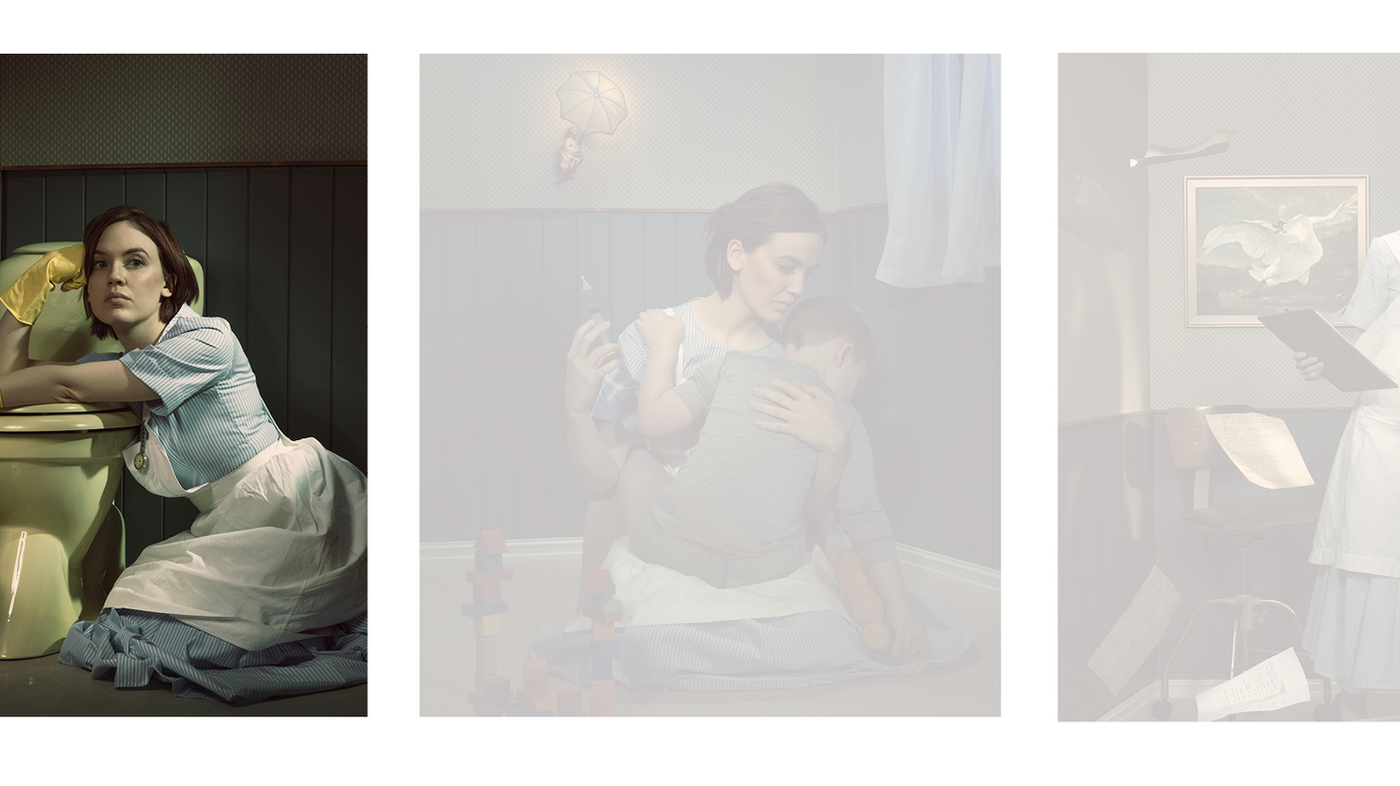
Nursing as personal competence
In the special edition, there is little mention of nursing competence in clinical issues. Interviews were conducted with personnel with competence from various branches of specialist nursing. In these texts, the specialist nurses emphasise knowledge that is specific to their specialisation.
However, personal competence in patient interaction is considered more important than specialist expertise. Per Nortvedt writes about the nurse based on Nightingale’s understanding:
‘The nurse must use empathy and imagination to be able to picture themself in the patient’s situation, change places with him or her and imagine themself in his or her world of experience. The nurse must also have an inherent sensibility’ (22, p. 68).
Clinical competence, which makes visible the link between nursing knowledge and tasks, is not described to any great extent. Nursing is described as a presence and is linked to the ability to be with the patient and see that person.
This can be understood as an individualised competence that is played out in patient interactions, based on the nurse as a fellow human being: ‘My most important tool is myself’, says a school nurse who will be teaching a lower secondary school class about sexuality (23, p. 80).
Martinsen was interviewed about her views on nursing. Her emphasis was on the practical aspects as opposed to theoretical competence, with concepts such as ‘taking responsibility for the nursing care’, ‘thoughtful young people’, and particularly ‘the nurse’s hands’ (24, p. 74).
When commenting on nurses wanting to increase their competence, Martinsen asserts that the concept of competence is a smoke screen, and asks if it is a concept we need (24, p. 75). Thus, competence is juxtaposed with human presence, as if theoretical competence and knowledge stand in the way of care and closeness.
The midwife’s descriptions are the exception in the description of clinical nursing competence (25). She refers to tasks and emphasises that clinical follow-up requires special competence:
‘Along with good communication, my hands are my most important tool. With them, I take Leopold’s hand and feel, among other things, whether the baby is in a breech or cephalic position. My fingers estimate the dilation of the cervix, the length of the cervix and the stage of labour’ (25, p. 85).
The portrayal of the nurse with patients or professional partners in the photo project is limited. Only two of the images show her interacting with others. In one image, she is with a child and in another she is with an adult woman.
The nurse appears tired and alone in the photo series. The dialogic aspect is missing, as is interaction with colleagues. The image shows a distance and remoteness to the situation, with a nostalgic darkness.
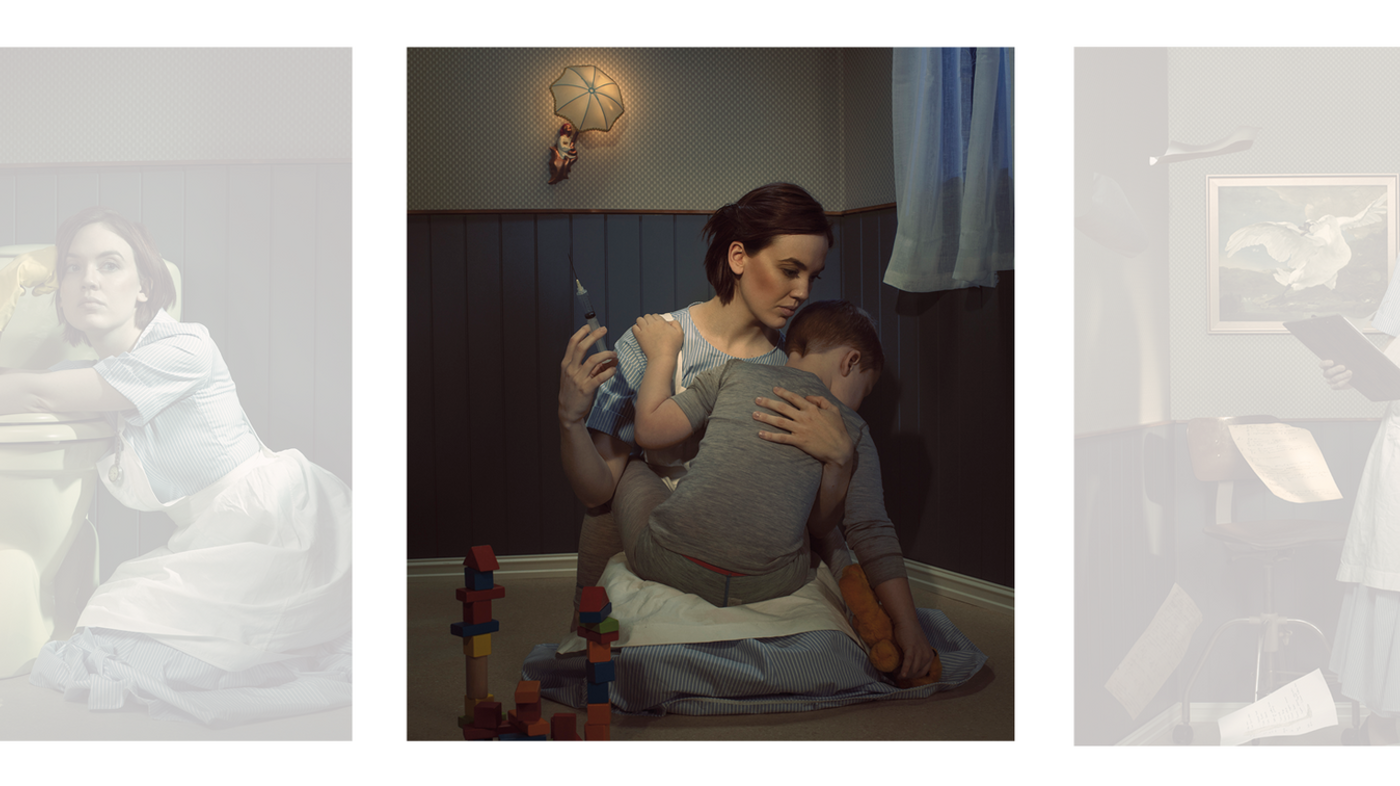
Nursing as a profession under threat
The images and text can be interpreted to mean that nurses perceive their profession as under threat in various ways. One of the last images in the photo project shows a copy of the painting ‘The Threatened Swan’ (p. 150) by the Dutch painter Jan Asselijn, from 1650, on the wall in the background. The painting depicts a swan under threat aggressively defending its nest. The photograph’s chaotic perspective together with the painting and the uneasiness of the situation give an impression that something is under threat.
The uniform worn by the nurses in the photo project harks back to an earlier era and is a romanticisation of the past. Looking back seems to have a stronger impact than looking into the future. This also applies to the presentation of the theorists, where historical theorists such as Nightingale, Henderson, Orem and Travelbee are highlighted. Today’s theorists and researchers are given limited space.
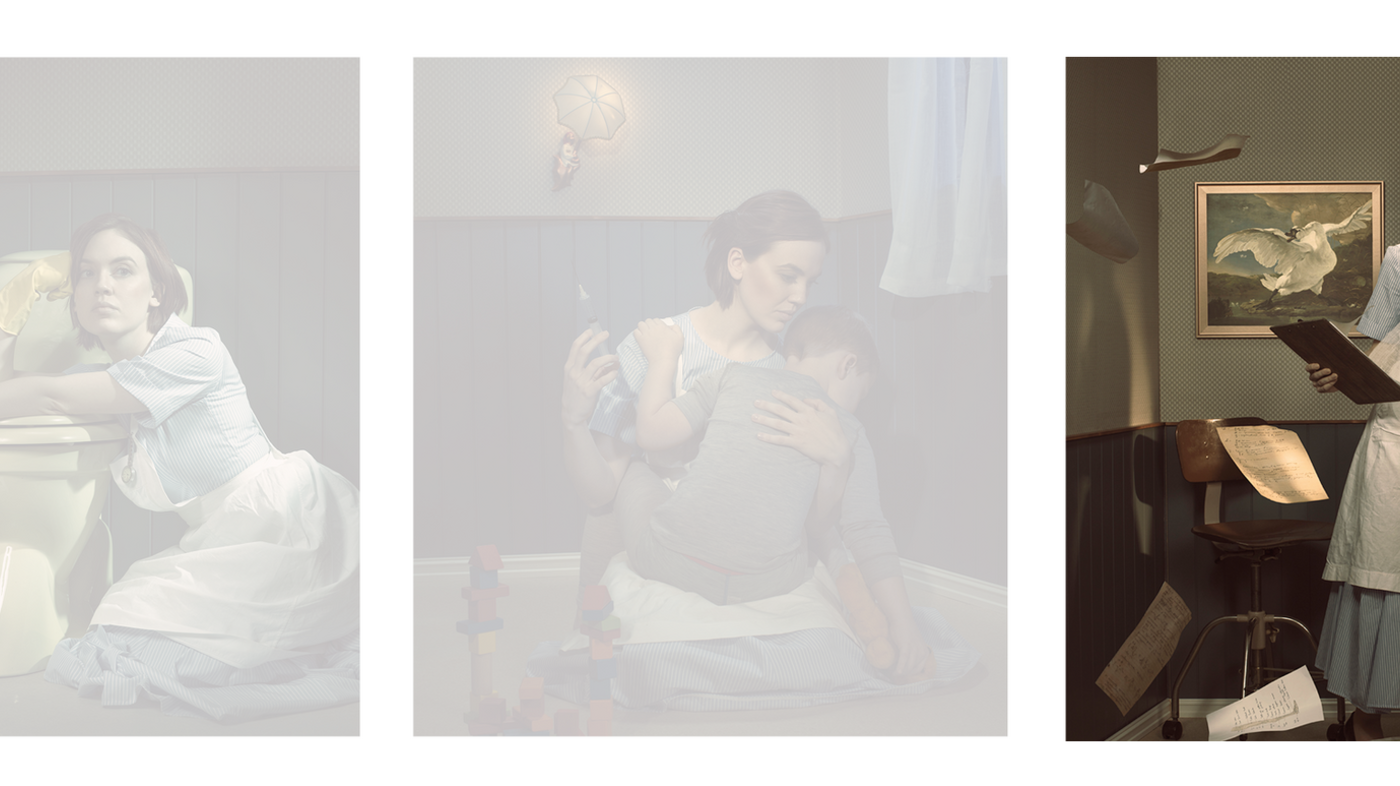
The possibility that the profession may be under threat is also made visible through the texts. Kirkevold (26) writes:
‘It is my contention that without distinct nursing input that can clearly and comprehensibly make a case for when and why patients need professional nursing care, one cannot fight convincingly for the patient [...] to receive the necessary nursing care’ (p. 60 ).
In Kirkevold’s view, nursing is something that should not be taken for granted. There must be a professional argument for the need for nursing care. Kirkevold points out that one of the threats to nursing is the demand for multidisciplinarity. She argues that nurses need a collective voice in order to stand stronger. Her use of language is interesting, almost intense, with the use of terms such as ‘without distinct nursing input’ and ‘fight’ (26).
Martinsen points out that the culture in the health service is threatening the nursing profession due to the pressure nurses work under, and their commitment to the patient (24):
‘Because this is a feeling of guilt that nurses should not always have to take on. It is culturally created and peremptory, like a duty: Do it, do it, do it! The ethics disappear, because you become so concerned with what the culture commands. The use of welfare technology is supposed to improve things, but instead it means the nurses have more work. [...] The feeling of guilt must be directed towards a health service that is governed by finances and production, with the pressure of time constraints and documentation requirements that can make care difficult’ (p. 73).
Lill Sverresdatter Larsen (27) claims that ‘nurses need concepts that help them to understand the place that organisational work has in the practice of nursing’ (p. 64).
This statement can be linked to the fact that nurses have insufficient organisational knowledge, and that they allow the health service’s needs govern to a greater extent than specific nursing knowledge. One of the threats could be that the nurses adapt to any system, which can result in a ‘stopwatch mentality’. In the special edition, the home care nurse is portrayed as a person with little time:
‘She is on schedule for seeing the next patient. […] Medicine distribution and a possible shower, it says on this job. When was the last time she had a shower? It seems like it could be several weeks ago. – Can that be right? No, I certainly don't know. It was a long time ago, she says. Ten minutes later she is back in the car. The medicine has been administered. There was no shower’ (28, p. 23).
The time factor is portrayed as a threat to the professionalism of the profession. The home care nurse is governed by the system, the clock and the medical tasks. The message is that she chooses not to take care of the patient’s personal hygiene.
The discussion about competence versus staffing levels is taken up by Jan Inge Pettersen, HR Director at Akershus University Hospital. He points to a need to employ nursing associates to relieve the nurses, so that they can take care of the nursing duties (p. 49).
Discussion
This study elucidates how nursing is described and legitimised. It also refers to how the lack of authority comes to light in the special edition. The study does not cover how the nurses’ actions are justified to any great extent, which makes it difficult to see how abstract knowledge is used.
In this chapter, we will focus on the legitimacy of nursing and how it is portrayed and can be understood from the perspective of the theory of professions.
Authority and professional legitimacy?
Historically, nursing has had a tradition of distancing itself from medical disciplines as it developed into an independent profession (2). Meerabeau (29) points to how nurses have worked to find their place close to the medical field, whilst experiencing a clash of interests. This could explain why the nurses’ emphasis differs from that of the doctors who assess, diagnose and treat patients. The importance that is attached to phenomenology and personal competence may be a consequence of this.
Olsvold points to the nurses being lower down the hospital hierarchy, and claims that nursing lacks authority over its own profession (21). In this study, the nurses seem to have no boundaries and little awareness of their own place in the system. As the analysis shows, nursing is portrayed to be far from nurses’ reality in many ways. Many are calling for a description of and knowledge about nursing that better reflects the working reality (8, 9).
Abbott’s (12) main point about jurisdiction, i.e. the profession’s responsibility for setting professional boundaries, may seem challenging for nursing. The special edition’s portrayal of the profession as having no demarcation lines does not suggest a profession with authority and legitimacy. This lack of demarcation can also be a reflection of the universality of the discipline, where specialised areas of knowledge are not prominent.
Kirkevold’s descriptions (26) of a collective voice to ensure nursing care for patients support the need for clarity and demarcation. If we look at the regulations for nursing education (30), they have a universal approach. The discipline-specific theoretical perspective is absent.
There is no mention of specific diseases or clinical pictures or whether the patient is premature, a child, a teenager or an adult. The requirements imposed on the candidates by the regulations are extensive and have little to no boundaries. The regulations reinforce the image of an absence of demarcation lines.
Adaptation to external circumstances as opposed to own discipline
The results show a profession that adapts to norms and structures in the health service. The descriptions of a discipline with no demarcation lines create associations with an occupational group that adapts to external factors rather than standing up for its own professional assessments. One question may be whether nurses have real opportunities to exert influence, and to what extent they allow themselves to be influenced by external factors – whether it is a choice to allow themselves to be governed, or whether it is consideration for the patients that governs them.
Grimen (31) argues that in health education subjects, including nursing, students should not only study the world, but should also intervene in the world, for the benefit of patients. The practical dimension is therefore not only about applying knowledge, it also has a normative side, which deals with moral, political and legal discretion (p. 73).
However, the absence of demarcation lines can be interpreted as the nurses adapting to the patients’ needs, which is a clear societal mandate in a health service with slogans such as ‘the patient comes first’ and ‘the patient’s health service’.
One question that can be asked is whether nurses promote their function primarily by virtue of their personal characteristics and their moral discretion rather than by highlighting their shared professional knowledge and competence. There is an asymmetric relationship between the professional who applies knowledge and the recipient of the service, who is dependent on the knowledge (32).
One of the consequences of a discipline with no demarcation lines and an individual perspective can be that the asymmetric relationship between the patient and the nurse is challenged or terminated, which can also threaten the legitimacy of the profession.
Conversely, the nurses’ personal competence can create associations to an independent professional practitioner who works according to their own assessments. However, the absence of professionally articulated assessments as a basis for the actions can also be interpreted to mean that science has little place in the profession.
According to Abbott (12, p. 71), the profession’s right to decide must be constantly defended, which is reflected and created through the public perception of what the nursing profession is. It is not only external structures that are responsible for creating a discipline with no demarcation lines. The texts show that even actors within nursing claim that it is difficult to set boundaries in the discipline (18).
The actors’ perceptions of what nursing is in an empirical sense, as we have studied in this article, are not geared towards providing a basis for understanding what knowledge is given legitimacy in the context of a professional strategy. The knowledge that seems to be legitimised through this study is experiential knowledge rather than academic knowledge. Whether the knowledge base is implicit in the practice of nursing or is an integral part of the nurse’s competence is not particularly clear.
It is also unclear whether the practical tasks are based on knowledge that is relevant to include in a profession’s knowledge base (7). Conversely, the midwife describes the complexity of her competence in the interaction with the patient in labour (25).
Individual-oriented with subjective perspectives
In the texts, the nurses rarely highlight their specific competence through collective reflections and concepts related to actions with abstract or theoretical nursing knowledge. When personal knowledge is dominant, it can create ambiguity in what is collective, and make it difficult to frame the nursing profession. Referring to a person, not a discipline, as is done in part 5, ‘For me, nursing is about’, is individual-oriented and linked to subjective perspectives.
The images show the nurse on her own, with little or no interaction with colleagues or patients. This is in contrast to nurses’ working lives, where they normally have contact with patients and their families, as well as colleagues.
It is not possible to analyse a profession without viewing it in its context. Abbott (12) is interested in how knowledge is legitimised, and the gender perspective may be a factor. Meerabeau (29) describes nursing as a gendered professional domain. Despite the importance that nursing is given by society, for example through praise, she points out that ideals of professional knowledge are often dismissed as unrealistic and sentimental.
It may also be, as Dahle (33) points out, that female-dominated professions have historically been subject to professional invisibility and disparagement. This notion is supported by Risjord (34), who claims that while the nurses’ role seems necessary for the work of the doctors, their efforts go largely unnoticed (p. 72).
Conclusion
The study shows that the portrayal of nursing in the special edition of the Norwegian Nursing Magazine, entitled ‘#What is nursing really?’ can be understood as having no demarcation lines, as personal competence, and as a profession under threat. Knowledge discussions get little coverage in the publication. What is emphasised, however, is experiential knowledge – particularly personal and interpersonal competence.
What nurses have knowledge about, how they apply knowledge in their work, and how knowledge is developed, seem to be overshadowed by the descriptions of the nurses’ personal experiences and competence. The nurses are perceived in practice as the glue in the organisation, someone who fills the ‘gaps’, and they do not make clear arguments for professional nursing, which bolsters the image of the nursing profession as having no demarcation lines.
The findings indicate that the nursing profession’s authority and professional legitimacy appear to be challenged and threatened due to the tendency to adapt to structures and norms in the health service rather than standing by clinical assessments.
We would particularly like to thank Professor Emeritus Lars Inge Terum and the research group Educational Research, both at OsloMet – Oslo Metropolitan University, for their valuable input and comments in relation to our writing of the article.
The authors declare no conflicts of interest.
References
1. Bergsagel I. 6 av 10 sykepleiere bruker daglig tid på oppgaver de mener andre burde utføre. Tidsskr Sykepl. 06.02.2019. Available at: https://sykepleien.no/2019/02/6-av-10-sykepleiere-bruker-daglig-tid-pa-oppgaver-de-mener-andre-burde-utfore (downloaded 28.06.2022).
2. Lund EC. Virke og profesjon. Norsk Sykepleierforbund gjennom 100 år (1912–2012). Bind 1. Oslo: Akribe; 2012.
3. Kirkevold M. Er det på tide å bygge bro over kunnskapskløften i sykepleiefaget? In: Alvsvåg H, Bergland Å, Førland O, eds. Nødvendige omveier: en vitenskapelig antologi til Kari Martinsens 70-årsdag: Cappelen Damm Akademisk; 2013. pp. 265–75.
4. Torjesen D. Kunnskap, profesjon og ledelse. Kunnskapsperspektiver på ledelse i norsk helsetjeneste. Tidsskrift for samfunnsforskning. 2007;48(2):275–90.
5. Alligood M. The nature of knowledge needed for nursing practice. In: Alligood M, Tomey A, eds. Nursing theory: Utilization & application. St. Louis, Missouri: Mosby; 2010. pp. 3–15.
6. Jensen K, Knutstad U. Slik har sykepleieforskningen utviklet seg. Norwegian Journal of Clinical Nursing . 2019;14(75607):e-75607. DOI: 10.4220/Sykepleienf.2019.75607
7. Heggen K. Introduksjon til den norske utgaven. I: Benner P, Supthen M, Leonard V, Day L. Å utdanne sykepleiere – behov for radikale endringer. Oslo: Akribe; 2010. pp. 9–21.
8. Allen D. Re-conceptualising holism in the contemporary nursing mandate: From individual to organisational relationships. Social Science & Medicine. 2014;119:131–8. DOI: 10.1016/j.socscimed.2014.08.036
9. Hellesø R, Larsen LS, Obstfelder A, Olsvold N. Hva er sykepleie? Sykepleien. 2016;104(8):58–60. DOI: 10.4220/Sykepleiens.2016.58491
10. Thorne S. Does nursing represent a unique angle of vision? If so, what is it? Nursing Inquiry. 2015;22(4):282–4. DOI: 10.1111/nin.12128
11. Gautun H. En utvikling som må snus. Bemanning og kompetanse i sykehjem og hjemmesykepleien. Oslo: Velferdsforskningsintituttet NOVA, Oslomet – storbyuniversitetet; 2020. NOVA-report 14/2020. Available at: https://oda.oslomet.no/oda-xmlui/bitstream/handle/20.500.12199/6417/NOVA-Rapport-14-20%20.pdf?sequence=3&isAllowed=y (downloaded 28.06.2022).
12. Abbott A. The system of professions: an essay on the division of expert labor. Chicago: University of Chicago Press; 1988.
13. Sykepleien. Temanummer: #Hva er egentlig sykepleie? Sykepleien. 2019:105(1). Available at: https://sykepleien.no/2019/02/hva-er-egentlig-sykepleie-0 (downloaded 13.06.2022).
14. Braun V, Clarke V, Hayfield N, Terry G. Thematic analysis. In: Liamputtong P, ed. Handbook of research methods in health social sciences. Singapore: Springer; 2019. pp. 589–97.
15. Rose G. Visual methodologies – an introduction to researching with visual materials. 4th ed. London: SAGE Publications; 2016.
16. Rose G, Christiansen HC. Analyser af billedmedier – det digitale perspektiv. 3rd ed. Frederiksberg: Samfundslitteratur; 2015.
17. Tholens B. Sykepleie – et grensetilfelle. In: #Hva er egentlig sykepleie? Sykepleien. 2019:107(1). pp. 8–9.
18. Elstad I. Grunnleggjande sjukepleie gjeld liv og død. I: #Hva er egentlig sykepleie? Sykepleien. 2019:107(1). pp. 12–6. DOI: 10.4220/Sykepleiens.2018.74511
19. Olsvold N. Hierarkiet vi ikke snakker om. I: #Hva er egentlig sykepleie? Sykepleien. 2019:107(1). pp. 142–3.
20. Helmers A. Sykepleieren som må gjøre alt. I: #Hva er egentlig sykepleie? Sykepleien. 2019:107(1). pp. 37–41.
21. Helmers A. – Skulle ønske jeg kunne be sykepleiere si nei til arbeidsoppgaver. I: #Hva er egentlig sykepleie? Sykepleien. 2019:107(1). pp. 41–5.
22. Nortvedt P. Tilbake til Nightingale. I: #Hva er egentlig sykepleie? Sykepleien. 2019:107(1). pp. 66–9.
23. Hofstad E. – Mitt viktigste verktøy er meg sjøl. I: #Hva er egentlig sykepleie? Sykepleien. 2019:107(1). pp. 80–1.
24. Fonn M. – Pleien tar den tiden den tar. I: #Hva er egentlig sykepleie? Sykepleien. 2019:107(1). pp. 70–5.
25. Hofstad E. Jordmor på toppen. I: #Hva er egentlig sykepleie? Sykepleien. 2019:107(1). pp. 84–5.
26. Kirkevold M. Trenger vi sykepleieteori? I: #Hva er egentlig sykepleie? Sykepleien. 2019:107(1). pp. 58–61.
27. Avdagic D. Mener det usynlige arbeidet må beskrives bedre. I: #Hva er egentlig sykepleie? Sykepleien. 2019:107(1). pp. 64.
28. Helmers A. – Jeg teller ikke minutter. I: #Hva er egentlig sykepleie? Sykepleien. 2019:107(1). pp. 20–5.
29. Meerabeau E. Be good, sweet maid, and let who can be clever: a counter reformation in English nursing education? International Journal of Nursing Studies. 2004;41(3):285–92. DOI: 10.1016/j.ijnurstu.2003.09.002
30. Forskrift 15. mars 2019 nr. 412 om nasjonal retningslinje for sykepleierutdanning. Available at: https://lovdata.no/dokument/SF/forskrift/2019-03-15-412 (downloaded 13.06.2022).
31. Grimen H. Profesjon og kunnskap. In: Molander I, Terum LI, eds. Profesjonsstudier. Oslo: Universitetsforlaget; 2008. pp. 71–87.
32. Molander A, Terum LI. Profesjonsstudier – en introduksjon. In: Molander A, Terum, LI, eds. Profesjonsstudier. Oslo: Universitetsforlaget; 2008. pp. 13–53.
33. Dahle R. Profesjon og kjønn. In: Molander A, Terum LI, eds. Profesjonsstudier. Oslo: Universitetsforlaget; 2008. pp. 216–32.
34. Risjord M. Nursing knowledge. Science, practice, and philosophy. Chichester: Wiley-Blackwell; 2010.
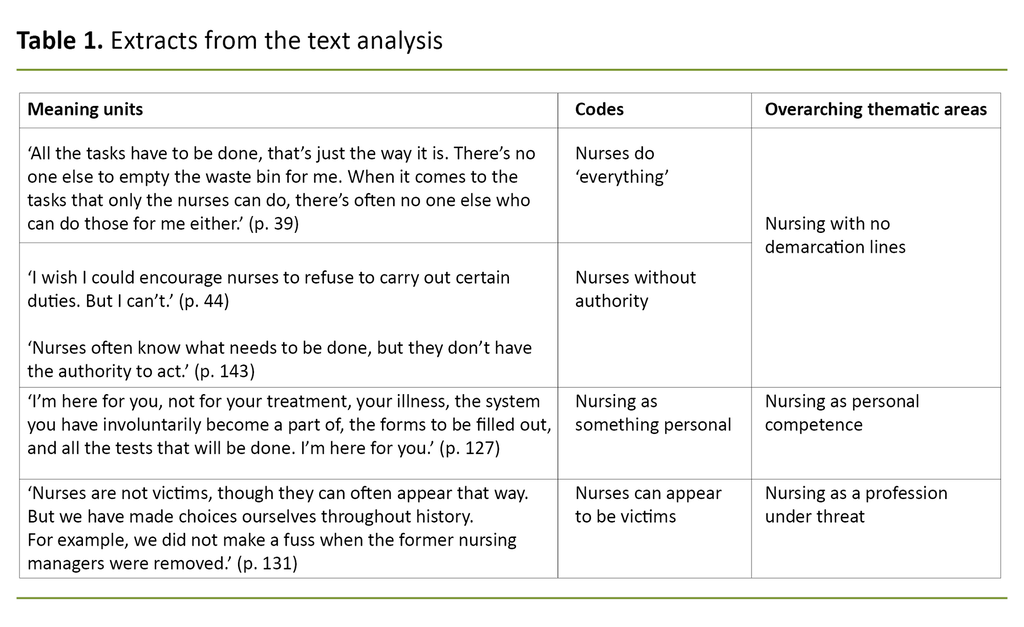
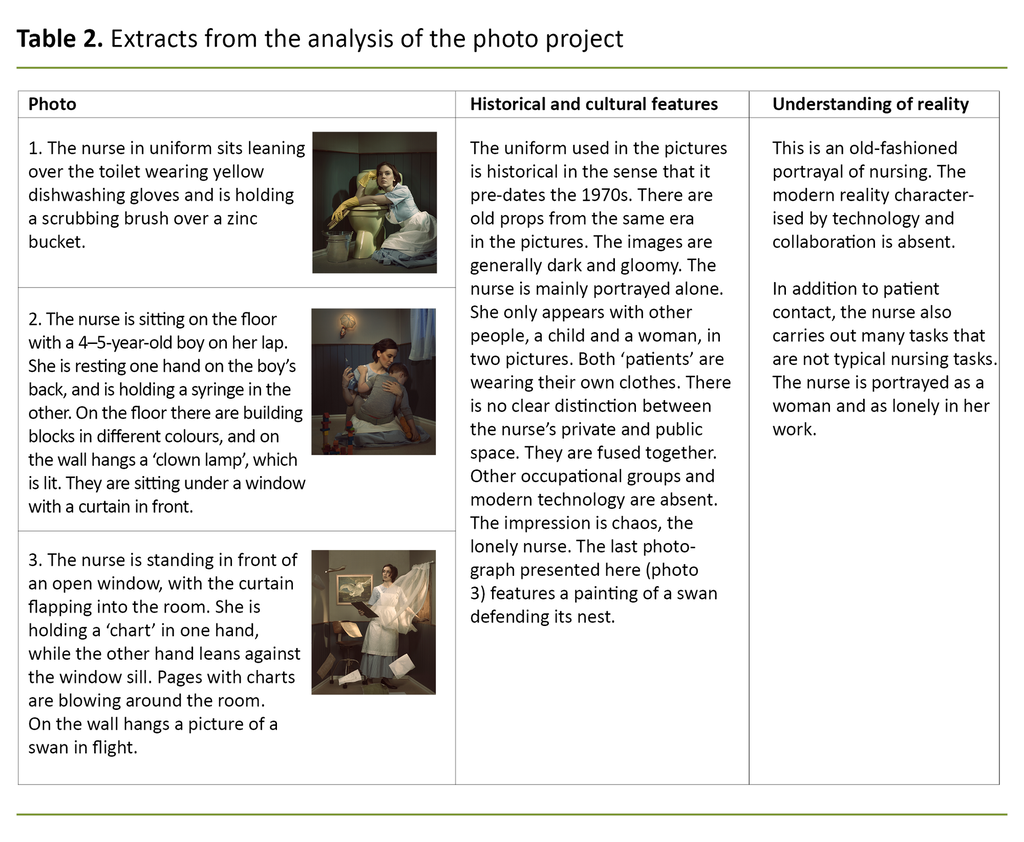






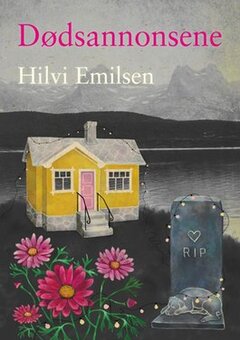
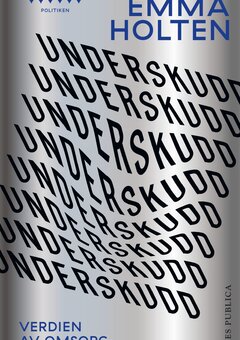
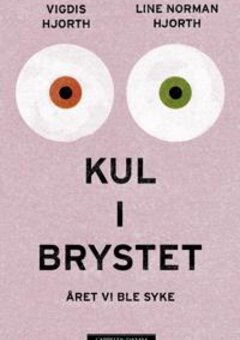
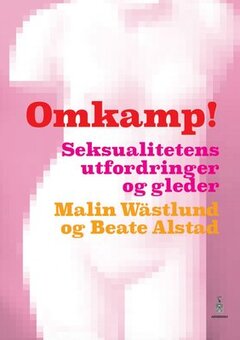
Comments